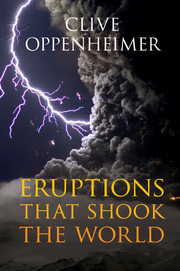Book contents
- Frontmatter
- Contents
- Preface
- Acknowledgements
- 1 Fire and brimstone: how volcanoes work
- 2 Eruption styles, hazards and ecosystem impacts
- 3 Volcanoes and global climate change
- 4 Forensic volcanology
- 5 Relics, myths and chronicles
- 6 Killer plumes
- 7 Human origins
- 8 The ash giant/sulphur dwarf
- 9 European volcanism in prehistory
- 10 The rise of Teotihuacán
- 11 Dark Ages: dark nature?
- 12 The haze famine
- 13 The last great subsistence crisis in the Western world
- 14 Volcanic catastrophe risk
- Appendix A Large eruptions
- Appendix B Further reading and data sources
- References
- Index
5 - Relics, myths and chronicles
Published online by Cambridge University Press: 01 June 2011
- Frontmatter
- Contents
- Preface
- Acknowledgements
- 1 Fire and brimstone: how volcanoes work
- 2 Eruption styles, hazards and ecosystem impacts
- 3 Volcanoes and global climate change
- 4 Forensic volcanology
- 5 Relics, myths and chronicles
- 6 Killer plumes
- 7 Human origins
- 8 The ash giant/sulphur dwarf
- 9 European volcanism in prehistory
- 10 The rise of Teotihuacán
- 11 Dark Ages: dark nature?
- 12 The haze famine
- 13 The last great subsistence crisis in the Western world
- 14 Volcanic catastrophe risk
- Appendix A Large eruptions
- Appendix B Further reading and data sources
- References
- Index
Summary
… many believe that the terrible monster is already dead; but I think that he is just resting after his exertions, and that someday he will surely come out of his hiding place again …
Ayta folkloreSince large eruptions are rare, to understand the wider spectrum of volcanic activity requires delving into the past. The preceding chapter outlined how the rock record, combined with assorted proxies for climatic and environmental conditions such as tree rings and ice cores, yields tremendous information on the nature and atmospheric impacts of past eruptions. This chapter extends the theme of ‘forensic volcanology’ by examining what can be learnt of the complex and long-term interactions and intersections between people, volcanoes and volcanic activity. In this regard, both archaeology and memories and records of eruptions in oral or inscribed forms offer a mine of information since they offer insights into both the physical aspects of past eruptions and social responses to living on volcanoes. The investigation and scope of these sources is introduced here.
Not only can impacts of some of the very largest eruptions be examined – events more extreme than anything seen in the historic period – but it is possible to evaluate how different societies have flourished, coped, declined or collapsed in the face of eruptions of different style and scale.
- Type
- Chapter
- Information
- Eruptions that Shook the World , pp. 109 - 139Publisher: Cambridge University PressPrint publication year: 2011



